


 |
See more Artzybasheff in issue 2 of |

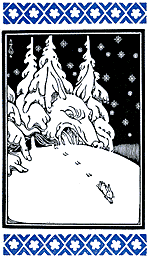 How does one describe or categorize Boris
Artzybasheff? From his very earliest work (the fleeing rabbit
from Verotchka's Tales at left and The Undertaker's
Garland centaur at right) in 1922 as a 23 year old immigrant
from Russia to his 200+ Time Magazine covers over a 24-year
span, there is a common thread of strong design and a light heart.
Equally at home with a portrait of Stalin and a Venusian do-it-yourselfer,
he was a master of composition and a superb draughtsman.
How does one describe or categorize Boris
Artzybasheff? From his very earliest work (the fleeing rabbit
from Verotchka's Tales at left and The Undertaker's
Garland centaur at right) in 1922 as a 23 year old immigrant
from Russia to his 200+ Time Magazine covers over a 24-year
span, there is a common thread of strong design and a light heart.
Equally at home with a portrait of Stalin and a Venusian do-it-yourselfer,
he was a master of composition and a superb draughtsman.
He illustrated some 50 books, several of which he wrote. While
his Time covers showcased his work to millions, he probably
made the biggest impression on the American public with his insightful,
satirical and powerful images done for Life Magazine in
the early forties on the various faces of war. These humanize
the aspects and weapons and villains of WWII in a comic but sobering
way.
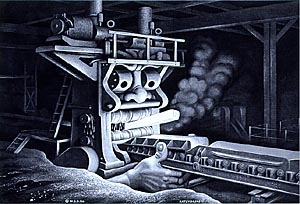
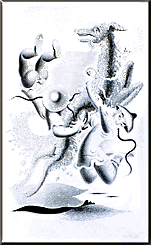 Many of these appear in his great book, As I See. Also shown in great abundance therein are his Mechinalia
- his anthropomorphic tools ranging from a monkey wrench to The
Blooming Mill at right. We can't recommend this book enough.
Just the hilarious Neurotica would be a sufficient content,
but with images as diverse as the one at left from The Circus
of Dr. Lao and others reminiscent of Wally Wood, Hirschfeld, Dali, Disney and Wolverton, the
full range of his work becomes apparent.
Many of these appear in his great book, As I See. Also shown in great abundance therein are his Mechinalia
- his anthropomorphic tools ranging from a monkey wrench to The
Blooming Mill at right. We can't recommend this book enough.
Just the hilarious Neurotica would be a sufficient content,
but with images as diverse as the one at left from The Circus
of Dr. Lao and others reminiscent of Wally Wood, Hirschfeld, Dali, Disney and Wolverton, the
full range of his work becomes apparent.
"Range"
is the proper word for Artzybasheff. See the sampling of Time
covers below. Realistic portraits and almost surreal backgrounds,
carefully crafted to suit each individual assignment. Always unique
and fresh, yet unmistakably Artzybasheff.
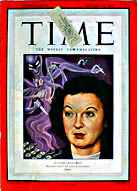
|
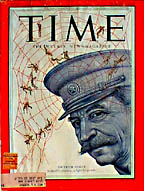
|
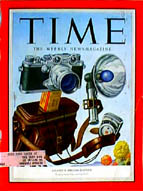
|

|
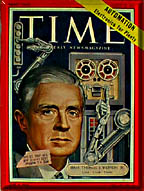
|
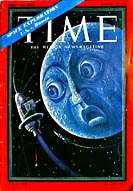
|
|
|
|
|
|
|
|

 Some other stellar examples of his art and
his styles can be found in Padraic Colum's Creatures
from 1927 - see the powerfully designed b&w "pyrolin"
cut at left. The sword-wielding, purple-caped horseman is from
Three and The Moon (1929), a collection of legends
from Normandy, Provence, and Brittany. Other
titles in this highly graphic b&w "woodcut" style
include Orpheus Myths of the World (another Colum
title from 1930) and Behind Moroccan Walls (1931).
After 1940, he devoted himself to commercial art. He was also
an expert advisor to the U.S. Department of State, Psychological
Warfare Branch during WWII. After seeing the Neurotica drawings
in As I See, this becomes less of a puzzlement.
Some other stellar examples of his art and
his styles can be found in Padraic Colum's Creatures
from 1927 - see the powerfully designed b&w "pyrolin"
cut at left. The sword-wielding, purple-caped horseman is from
Three and The Moon (1929), a collection of legends
from Normandy, Provence, and Brittany. Other
titles in this highly graphic b&w "woodcut" style
include Orpheus Myths of the World (another Colum
title from 1930) and Behind Moroccan Walls (1931).
After 1940, he devoted himself to commercial art. He was also
an expert advisor to the U.S. Department of State, Psychological
Warfare Branch during WWII. After seeing the Neurotica drawings
in As I See, this becomes less of a puzzlement.
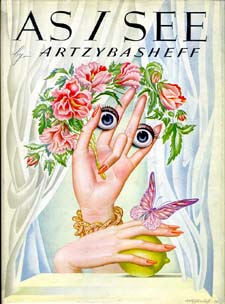
 As mentioned above, As I See
is the book to find. Fortunately, Ken Steacy shepherded a reprint by Titan Books in 2008. The playful dust jacket image (at
left) is repeated as the frontispiece. Other fine examples of
his color work and his strong design sense can be found in his
advertising work, like the Bermuda Clipper ad at right.
(This image courtesy of a photograph shared with us by Arthur
B. Metcalfe, an inveterate Artzybasheff collector.) Other advertising
work was less graphic/design-oriented and more tongue-in-cheek
like the very colorful spiel for the Casco Electri-craft Power
Tool Kit below. The caption reads "Make Money! Sell Power
Tool Kits by Mail on Venus!" This from 1946.
As mentioned above, As I See
is the book to find. Fortunately, Ken Steacy shepherded a reprint by Titan Books in 2008. The playful dust jacket image (at
left) is repeated as the frontispiece. Other fine examples of
his color work and his strong design sense can be found in his
advertising work, like the Bermuda Clipper ad at right.
(This image courtesy of a photograph shared with us by Arthur
B. Metcalfe, an inveterate Artzybasheff collector.) Other advertising
work was less graphic/design-oriented and more tongue-in-cheek
like the very colorful spiel for the Casco Electri-craft Power
Tool Kit below. The caption reads "Make Money! Sell Power
Tool Kits by Mail on Venus!" This from 1946.
 Artzybasheff died in 1965. A book he illustrated,
Dhan Mukerji's Gay Neck, was awarded the Newbery
Medal in 1928. Most of his book illustrations favored the crisp
line and careful composition that are so distinctively his. Other
books to look for include: Feats on the Fiord (1924)
(with a surprising color frontispiece), The Wonder Smith
and His Son (1927), Mizra, Son of the Sword
(1934), the dust jacket engraving for All Things Are Possible
(1935) and some atypical, but stunning pencil (?) drawings for
Nansen (1940), probably the last book he illustrated.
Artzybasheff died in 1965. A book he illustrated,
Dhan Mukerji's Gay Neck, was awarded the Newbery
Medal in 1928. Most of his book illustrations favored the crisp
line and careful composition that are so distinctively his. Other
books to look for include: Feats on the Fiord (1924)
(with a surprising color frontispiece), The Wonder Smith
and His Son (1927), Mizra, Son of the Sword
(1934), the dust jacket engraving for All Things Are Possible
(1935) and some atypical, but stunning pencil (?) drawings for
Nansen (1940), probably the last book he illustrated.
 To find out more about Boris Artzybasheff, see:
To find out more about Boris Artzybasheff, see:
| Forty Illustrators and How They Work | Ernest W. Watson, 1946 Watson Guptill |
| The Illustrator in America 1880 to 1980 | Walt and Roger Reed, 1984 Madison Square Press |
| 200 Years of American Illustration | Henry Pitz, 1977 Random House |
| The Vadeboncoeur Collection of ImageS B&W 2 | Jim Vadeboncoeur, Jr. 2004 JVJ Publishing |
|
Illustrations copyright by their respective
owners. This page written, designed & © 1999 by Jim Vadeboncoeur, Jr. Updated 2011. |
Learn about other ILLUSTRATORS
